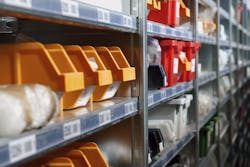The value of a having a dedicated parts and service assistant, part 1
More and more fleets and service providers are recognizing the benefits of having a dedicated parts and service assistant in their operation. That’s because this position can help increase fleet and/or service provider efficiency by keeping the technician focused on their primary task – fixing the truck.
A parts and service assistant can help maximize shop efficiency by limiting technician idle time and freeing the technician to concentrate on repairs and service. This assistant would move through the shop environment delivering parts, receiving cores and taking requests for parts from technicians in the work bays.
Additional benefits may include:
- Building a better understanding of actual shop needs.
- Helping to predict future shop needs.
- Allowing a hands-on approach for the technician and the parts specialist to determine parts needs within the work bay.
- Training entry-level parts specialists on existing and new technology.
Despite the advantages that a parts and service assistant can provide to a shop, it can be difficult to justify the need for such a position to upper management.
A How To
To help shops make the case for, and hire, a parts and service assistant, the S.16 Service Provider Study Group of the Technology & Maintenance Council (TMC) has developed a recommend practice (RP): RP 1605, Justification for a Parts and Service Assistant.
To date, the group – whose mission is to improve the efficiency and professionalism of the working relationship between repair work service providers and fleets – has issued or completed more than a dozen such RPs.
TMC RP 1605 focuses on four key areas: personnel, parts requisition forms, parts transporting and measurement. This column will discuss the first two of these areas. Parts transporting and measurement will be covered in the next column.
- Personnel – The parts and service assistant position may be filled successfully by either entry-level or experienced personnel. Assigning an experienced parts specialist to this position may lessen inefficiencies because the individual is more knowledgeable than a less experienced parts person.
For example, a more experienced parts specialist will have a better understanding of the actual needs of the technician and likely will be better at predicting needs.
On the other hand, filling this position with a less experienced parts specialist can help keep more experienced personnel in a high-traffic area, such as the phone room or front counter, while a less experienced parts specialist roams the shop delivering parts, receiving cores and collecting requests.
Some facilities also may find a less experienced parts specialist can take on additional duties which otherwise reduce technician efficiency, such as, cleaning diesel particulate filters, charging batteries, handling cores and warranty parts, etc.
Larger volume shops may have more than one parts specialist to process technician parts requests. Being able to move to the next available parts specialist when the primary parts specialist is busy helps to avoid technician idle time.
- Parts Requisition Form – A parts requisition form should be designed to help the technician interface effectively with the parts department.
On this form, the technician fills out pertinent information and writes a description of parts needed, and then presents the form to the parts and service assistant. This allows the technician to return to the work area and continue his or her assigned task(s) while the parts department processes the request.
In some situations, the parts and service assistant actually can complete this form in an interview-type forum, thus reducing technician administration time and allowing time to continue repairs.
Additional benefits to using a parts requisition form may include – but are not limited to:
- Getting all the parts required for a specific repair the first time.
- Providing a paper copy to audit transactions.
- Building templates for recurring repairs.
This form also can assist in tasks pertaining to warranty “failed parts” and cores. Documenting the need at the time the request is filled gives the fleet or service provider a process with an audit trail for this key area of parts handling.
- Electronic Parts Requisition Form – An electronic delivery method takes the effectiveness of this form to the next level. Electronic parts requisition form can be used when the technician has access to a PC or laptop in or near the work bay.
Sending an electronic notification of parts needed allows the technician to continue assigned task(s) while the parts department processes the request.
Up Next
These are just some of the recommended guidelines contained within RP 1605 that outline how a parts and service assistant can help fleets and/or service providers increase their efficiency by lessening the workload on technicians and keeping them where they are most needed: in the work bay.
This recommended practice is but one of more than 450 that TMC has issued over the years.
The next column will continue the parts and service assistant discussion with a look at parts transporting and benchmarking the performance of the parts and service departments.
Kenneth Calhoun is the outgoing chairman of TMC’s S.16 Service Provider Study Group. In February 2015, he was elected to TMC’s board of directors as its first service provider representative. He is also vice president of customer relations for Truck Centers of Arkansas (www.truckcentersar.com), a full-service dealership with headquarters in North Little Rock, Ark. TMC is North America’s premier technical society for truck equipment technology and maintenance professionals (www.trucking.org/Technology_Council.aspx). It is a part of the American Trucking Associations (www.truckline.com), the largest national trade association for the trucking industry.
About the Author
Kenneth Calhoun
Technology & Maintenance Council (TMC)
Vice President, Customer Relations, Truck Centers of Arkansas; Service Provider Director at Large, Technology & Maintenance Council (TMC) Board of Directors; Immediate Past Chairman, TMC S.16 Service Provider Study Group
